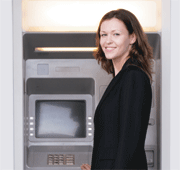On a campus near you . . . Houston’s Cougar 1 Card
In the Fall of 1997, the University of Houston began issuing the Cougar 1 Card to 38,000 students, faculty, and staff. The institution saw a need to better control access to facilities and ease payments on the campus and a decision had been made to eliminate the overlap that occurred with three separate departments issuing separate cards.
According to Jackie Mitchell, Cougar 1 Card Manager, “before we centralized the card office, the human resources department issued faculty and staff IDs, the registrar issued student IDs, and the residence halls issued dining hall cards.” A student worker or faculty member living in campus housing could have three unique ID cards from the University.
The system selected to consolidate and manage all card functions was Blackboard’s Optim system. The campus has built upon the original system adding modules in a phased approach. Today, functions include identification, privilege control, access control, and debit card sales.
Online access control into housing facilities and recreation centers are controlled via data from the magnetic stripe card. Parking gates are controlled by a separate card with proximity technology. Last year, the process of consolidating the multiple security systems on the campus began with a contract award to Best Access Systems.
Two separate declining balance accounts are provided via the card. A mealplan account enables the cardholder to spend deposited dollars at the Chartwell’s dining locations including the branded concept restaurants (e.g. Wendy’s, Smoothie King) on campus. The Flex declining balance account enables card-based payment at a variety of locations around the campus including the bookstore, campus c-stores, and branded concept restaurants as well as laundry and vending locations. This Flex account is the only method of payment in the residence hall laundry facilities.
Cardholders add money to their Flex account in the Cougar 1 Card office, at one of six Value Transfer stations, or via the web-based Online Card Office. At the Online Card Office, funds can be added to the account using a credit or debit card. Additional functionality includes access to account balances and transaction histories as well as lost/stolen card reporting.
According to Mitchell, the program has seena 65% increase in Flex account deposits since the launch of the Online Card Office. She credits the ease of use, convenience, and the facility for parents to add money to student accounts with much of this increase.
The Cougar 1 Cards are issued via a Datacard issuance system that is integrated with the Blackboard management system. Two photo capture stations and two card printers are utilized during normal times, with additional stations rented from Blackboard to handle peak times at the beginning of semesters. The card office is staffed by 3 full-time employees and 1 additional FTE divided among several part-time students. Hours of operation are Monday through Friday, 7:30 a.m. to 7:00 p.m. The card program is a unit of the Finance and Administration division.
Library patron identification occurs through a barcode printed on the back of the card at issuance. The responsibility is placed on the cardholder to register the barcode with the library. Until this has been done, materials may not be checked out from campus libraries. The barcode can be registered in person at the library or on the web.
Beginning Fall 2002, the Cougar 1 Card will gain enhanced financial capabilities through the University’s relationship with HigherOne. This optional service will add to the card a range of banking functionality that includes ATM utilization, point-of-sale purchasing at any location that accepts Visa-branded products, and traditional banking functions such as check writing and depository services. Additionally, electronic transfer of financial aid dollars to the account and direct deposit of payroll add to the convenience and cost savings for the university. While no physical bank branch will exist on the campus or in the community, the product is expected to be used as the primary bank account for students comfortable with on-line banking concepts.
Because the card will become a Visa product, a Visa logo will be added to the front of the card. Mitchell reports that there is ongoing discussion about whether the finished card will be issued from the campus card office or if a temporary card will be issued to students desiring the HigherOne account with the actual card mailed at a later point. In the past, the strict security restrictions imposed by Visa have mandated that all cards with the Visa logo be manufactured in a secure, approved facility.
Says Mitchell, “we are extremely excited about the broadened financial services that the HigherOne relationship will bring to our program. The majority of our students are commuters and our campus is located in a metropolitan area. To me this product is a perfect fit for such an environment.”
For more information on the University of Houston’s card program, visit them on the web at http://www.uh.edu/cougar1card.



